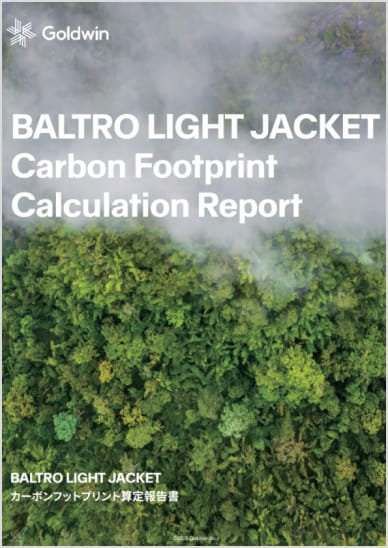Realization of a Carbon-free Society Sustainability
Basic Concept
The apparel industry is said to be an industry with extremely high CO2 emissions. Global warming is an urgent problem that requires a proactive response to achieve the 1.5% target adopted in the Paris Agreement. Our Group is committed to reducing greenhouse gas emissions through business activities that have a low environmental impact by using minimal resources and energy. Going forward, we aim to achieve carbon neutrality by reducing emissions at our directly managed stores, procuring raw materials that do not rely on fossil fuels through strengthening cooperation with suppliers, and reviewing our manufacturing processes.
Key Environmental Issues
We have been working to reduce energy use and CO2 emissions at our main offices since before. To further boost these efforts and to reduce CO2 emissions across the supply chain, we have included “Realization of a carbon-free society” as a key issue in our medium-term management plan. We will strengthen cooperation with suppliers, aiming to procure raw materials that do not come from fossil fuel sources, and to achieve carbon neutrality.
We are also promoting initiatives towards the realization of a carbon-free society, centered on our EMS Committee, chaired by our President and Representative of Board. The EMS Committee manages actual greenhouse gas emissions of each of our offices every month and strives to reduce these emissions. Progress is also reported at bi-annual Environmental Management Meetings.

Greenhouse Gas Emission Reductions
The Goldwin Group continues to actively reduce greenhouse gas emissions. The emissions from our offices in Japan in FY 2023 amounted to 128 t-CO2, while emissions from our directly managed stores totaled 2,158 t-CO2.
In FY 2023, for the first time we calculated our Scope 1, Scope 2, and Scope 3 emissions based on the GHG Protocol. Based on the results of these calculations, we will step up efforts to reduce GHG emissions. Specifically, as well as reducing Scope 1 emissions, which are directly emitted by Goldwin, the Company will reduce Scope 2 emissions by converting directly managed stores to renewable energy. In reducing Scope 3, category 1, emissions, which account for most of our GHG emissions, we will develop products with low CO2 emissions and strengthen cooperation with suppliers.
| Scope 1・2・3 | 262,864 |
|---|---|
| Scope1 | 312 |
| Scope2 | 1,974 |
| Scope3 | 260,578 |
| Category 1 *1 | 245,008 |
| Category 3 | 633 |
| Category 4 | 3,491 |
| Category 5 *2 | 41 |
| Category 6 | 850 |
| Category 7 | 941 |
| Category 12 | 9,614 |
*2 Calculation based on procured products
Undergoing third-party verification for greenhouse gas (GHG) emissions
To enhance the reliability of our greenhouse gas (GHG) emissions calculation, we underwent third-party verification from SGS Japan Inc. and announced the verification results.
We will continue to promote initiatives to reduce CO2 toward the realization of a carbon-free society and properly understand and manage the environmental impact associated with our business activities. We will also provide our stakeholders with accurate information in an easy-to-understand manner and accelerate initiatives to reduce environmental impact.
Greenhouse Gas Emitted from Procurement Logistics
The Goldwin Group is working to understand greenhouse gas emissions related to logistics, and found that 2,029 tons of CO2 was emitted in FY 2023. We completed carbon offsets by purchasing the same amount of emission allowances for FY 2024. Going forward, we will consider and implement measures to reduce our emissions.
Calculating the Carbon Footprint of Products
The Goldwin Group is working on calculating the carbon footprint of its products as a first step toward reducing Category 1 of Scope 3 emissions, which accounts for a large portion of greenhouse gas emissions from our Group. In FY 2024, we participated in the Ministry of the Environment’s FY 2024 Model Project for Carbon Footprint of Products and Services and calculated the carbon footprint of the Baltro Light Jacket, a product that symbolizes our outdoor apparel brand THE NORTH FACE. As a result, we found that the total greenhouse gas emissions throughout its life cycle amounted to 31.8 kg-CO2e.
This calculation revealed that approximately 80% of the product’s total emissions is generated during the raw material procurement stage. As a result, we have identified reducing emissions from materials, including fabrics, as important issues to be addressed. Based on these findings, we will strengthen collaboration with our suppliers and carry out initiatives
aimed at reducing emissions from raw materials. We will also expand the scope of carbon footprint calculations to a wider range of products within our Group, to further advance our efforts in understanding the current situation and making efforts to reduce emissions.
Details of the product
Product name
Baltro Light Jacket (Unisex)
Size
L
Material
<Outer fabric> Outer side: 100% nylon, Inner side: ePTFE
<Lining> 100% nylon
<Filling> 72% down, 20% rayon, 8% feather
Calculation unit
1 piece
Structural parts in calculation
Product body, storage bag, brand name, quality name, tag, product packaging plastic bag, etc.

| Raw materials procurement | 25.7 |
|---|---|
| Production | 0.1 |
| Distribution/sales | 1.3 |
| Use | 1.8 |
| Disposal | 2.8 |
| Total amount | 31.8 |
Reduction of Energy Use
The Goldwin Group continues to reduce greenhouse gas emissions.
Total energy consumption at our main business locations in Japan in FY 2023 was 34,547 GJ, which was a reduction from FY 2022. However, the inclusion of directly managed stores in the calculation from FY 2023 increased our consumption of city gas which is used mainly to power electricity and air conditioning for tenant stores in shopping mall. As a result, total energy consumption increased to 82,310 GJ. As for changes in the breakdown of other forms of energy, as a result of Goldwin Logitem switching from heavy oil A to electricity to power air conditioning, our consumption of heavy oil A was zero tons. In addition, as a consequence of making a clearer distinction between diesel oil and gasoline, the calculated amount of diesel oil increased compared to FY 2022. Expanding and refining what is counted in the calculation has improved the visualization of our energy use. In FY 2024, we will continue
our efforts for energy conservation to achieve further reductions.
| Unit | FY 2019 | FY 2020 | FY 2021 | FY 2022 | FY 2023 | ||
|---|---|---|---|---|---|---|---|
| Electricity | 1,000 kWh | 3,711 | 3,501 | 3,502 | 3,473 | 8,548 | |
| City gas | For onsite facilities | 1,000 m3 | 5.527 | 3.192 | 2.197 | 3.759 | 118.803 |
| LPG | For onsite facilities | t | 187.0 | 6.9 | 6.7 | 5.8 | 4.7 |
| Heavy oil A | ㎘ | 50.4 | 50.8 | 52.0 | 18.4 | 0 | |
| Gasoline | For vehicles | ㎘ | 16.0 | 11.0 | 18.9 | 20.3 | 18.6 |
| Diesel oil | For vehicles | ㎘ | 0.980 | 0.862 | 4.492 | ||
| Total energy | GJ | 48,898.9 | 37,765.5 | 37,979.9 | 36,372.2 | 82,310 | |
* Including results at stores, starting from FY 2023
Conversion to Renewable Energy
To reduce greenhouse gas emissions, our Group is shifting to renewable energy sources for the electricity we use. As part of these efforts, we have installed independent power generation systems using solar panels at our business premises in the Toyama region.
Previously, the scope of calculation was our main business locations in Japan. However, the inclusion of directly managed stores in FY 2023 resulted in an increase in our electricity consumption. Similarly, as a result of including directly managed stores in the scope of calculation, our overall ratio of renewable energy use decreased. Nevertheless, in FY 2023, the ratio of renewable energy use at our main business locations in Japan was 97.6%, indicating progress in the shift to renewable energy since FY 2022. By including directly managed stores in the scope of calculation, we will get a better visualization of the current situation and more refined calculations. We will continue to promote the switch to renewable energy sources for electricity used at our business premises and directly managed stores.
* Including results at stores, starting from FY 2023
Appropriate Management of Ozone-depleting Substances
Goldwin Group manages chlorofluorocarbon (CFC) used to fill air-conditioning units in accordance with standards set under the Act on Rational Use and Appropriate Management of Fluorocarbons. No CFC leakages were detected in FY 2023. Going forward, we will continue to comply with the law and to manage CFC emissions.
Future Issues
In FY 2023, we were able to cut greenhouse gas emissions at our Japanese offices above our targets. In addition, as a result of calculating greenhouse gas emissions from directly managed stores and Scope 3 emissions based on the GHG Protocol, we now have a better understanding of our total emissions. We will continue striving to keep track of our emissions accurately while proceeding with our efforts to ascertain emissions not only at our business locations and directly managed stores but also in our supply chain based on our medium- to long-term plan, and promote their reductions.

